Boobialla, or native juniper, is a common native shrub in southern Australia. Its edible berries have been widely eaten as bush tucker for centuries, but collecting the berries in the wild is illegal in most states.
In this article, we’re going to share the best ways to grow your own Boobialla at home, how to prepare it, and some of the best Boobialla varieties for your garden, no matter the size.
More...
Family: | Scrophulariaceae |
|---|---|
Genus: | Myoporum |
Species: | M. insulare |
Common Names: | Boobialla, native juniper, coastal boobialla |
Location: | Outdoor |
Type: | shrub, small tree |
Growth: | 6m tall |
Sun requirements: | Full sun |
Foliage Colour: | Green |
Flower Colour: | White |
Flowering: | Early summer |
Fruit: | Edible purple berries |
Maintenance level: | Low |
Poisonous for pets: | Leaves are toxic to pets and humans |
What is Boobialla?

Source: cottesloecoastcare.org
Boobialla is a widely occurring native tree or shrub. There are several growing forms, from prostrate shrubs to small trees, but all share similar edible berries, smooth lanceolate leaves with toothed edges, and small, honey-scented flowers.
Boobialla berries are small and round with smooth purple skins that ripen slowly through summer. They have a high sugar content but also bitter undertones that make them excellent for jams and preserves or to cut through the sharpness of gin.
Native Habitat of Myoporum insulare
Boobialla are native to southern Australia, growing largely along the coast on sand dunes and between rocks, but are found growing in Northern Australia where they notably flower for longer in the warmer weather, making them excellent garden plants.
Boobialla have naturalised in parts of South Africa, and are considered an invasive species in the Americas where they can happily self-seed anywhere with good drainage and a reasonably warm climate.
Best Boobialla Varieties to Grow in Australia
Boobialla is the name given to two Myoporum species; M. parvifolium and M. insulare. There are two common variations of each species; M. parvifolium ‘Purpurea’ and M. insulare ‘Prostrate’.
1. Myoporum parvifolium (Creeping Boobialla)Creeping Boobialla has bright green foliage, which sprawls for up to 6 metres from the centre of the plant, making it an excellent choice for rockeries or dry borders in full sun. This tough native shrub loves good drainage and copes well with drought, but benefits from generous weekly water if you plan on harvesting the berries in late summer. Click here for a detailed growing and care guide for the Creeping Boobialla. | 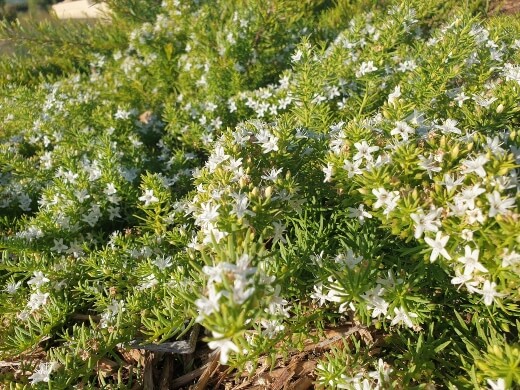 Source: mucheatreefarm.com.au |
2. Myoporum insulare ‘Prostrate’ (Prostrate Boobialla)Prostrate describes plants that grow horizontally along the ground. Rather than the creeping habit of M. parvifolium, M. insulare has more structure and grows in a mounded dome. Prostrate Boobialla grown in well-drained soil with an annual bark mulch can reliably reach a 4m spread, and a height of around 50cm, making it a great informal hedging plant to divide areas of the garden with wildlife-friendly native plants. |  Source: mucheatreefarm.com.au |
3. Myoporum parvifolium ‘Purpurea’ (Creeping Boobialla Purpurea)M. parvifolium ‘Purpurea’ is identical to its closest relative in all but one way; colour. While the mature leaves later in the season are green, and the plant hosts white flowers and purple berries, its spring foliage is a deep purplish red – hence ‘Purpurea’. Perfect for colour and seasonal interest. | 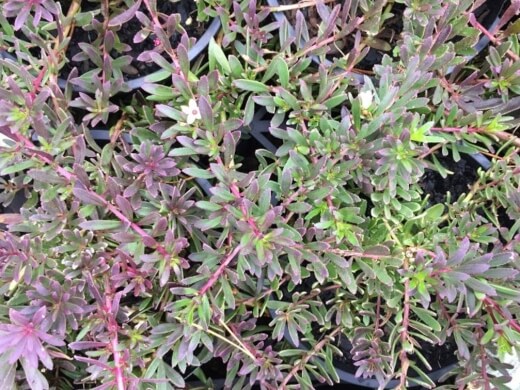 Source: plantmark.com.au |
4. Myoporum insulare (Common Boobialla)M. insulare, or the Common Boobialla, is the tree form of Boobialla. Growing to an ultimate height of 6m. Its spear-shaped leaves have toothed serrations around their borders near the tips, and they flower readily along each stem creating tight clusters of edible berries. | 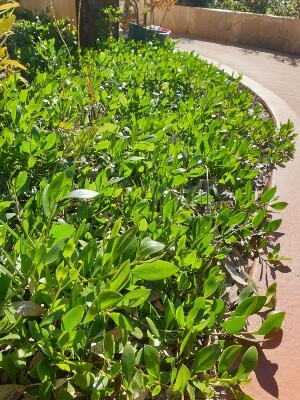 Source: mucheatreefarm.com.au |
1. Myoporum parvifolium (Creeping Boobialla)

Source: mucheatreefarm.com.au
Creeping Boobialla has bright green foliage, which sprawls for up to 6 metres from the centre of the plant, making it an excellent choice for rockeries or dry borders in full sun.
This tough native shrub loves good drainage and copes well with drought, but benefits from generous weekly water if you plan on harvesting the berries in late summer.
Click here for a detailed growing and care guide for the Creeping Boobialla.
2. Myoporum insulare ‘Prostrate’ (Prostrate Boobialla)

Source: mucheatreefarm.com.au
Prostrate describes plants that grow horizontally along the ground. Rather than the creeping habit of M. parvifolium, M. insulare has more structure and grows in a mounded dome.
Prostrate Boobialla grown in well-drained soil with an annual bark mulch can reliably reach a 4m spread, and a height of around 50cm, making it a great informal hedging plant to divide areas of the garden with wildlife-friendly native plants.
3. Myoporum parvifolium ‘Purpurea’ (Creeping Boobialla Purpurea)

Source: plantmark.com.au
M. parvifolium ‘Purpurea’ is identical to its closest relative in all but one way; colour. While the mature leaves later in the season are green, and the plant hosts white flowers and purple berries, its spring foliage is a deep purplish red – hence ‘Purpurea’. Perfect for colour and seasonal interest.
4. Myoporum insulare (Common Boobialla)

Source: mucheatreefarm.com.au
M. insulare, or the Common Boobialla, is the tree form of Boobialla. Growing to an ultimate height of 6m. Its spear-shaped leaves have toothed serrations around their borders near the tips, and they flower readily along each stem creating tight clusters of edible berries.
How to Grow Boobialla in Australia
Boobialla is easy to grow on any free-draining soil, but if you’ve got rich, loamy soil in your garden, don’t worry, there are some great hacks to grow Boobialla at home and improve your drainage, which is good for a wide range of native plants.
Plant Spacing
Prostrate Boobialla needs at least 4m to spread out and can develop quickly in a domed, wide-spreading plant. Provide plenty of space for these ground-cover shrubs.
For tree forming Boobialla, give them at least 1m on all sides and clear the soil of any weeds. Water well for the first summer after planting to help the roots establish, then leave it to cope with natural conditions, removing any competing plants beneath the canopy as it develops.
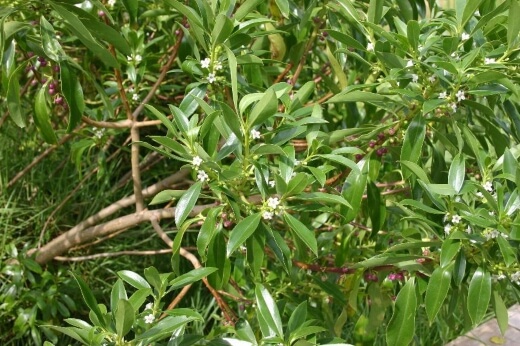
Source: nzflora.info
Sunlight Preference
Boobialla prefers full sun but can grow quite happily in the shade of houses, or other trees provided they stay in reasonably warm conditions and have good drainage.
Temperature
Boobialla are particularly unfussy about temperatures. They grow naturally along the south coast and are found growing in hotter parts of South Africa and northern Australia.
Interestingly, planting Boobialla in higher temperatures extends their flowering season by up to eight weeks. This isn’t ideal for harvesting berries but is good for gardeners looking for reliable summer flowering.
Best Soil for Growing Boobialla
Boobialla needs good drainage, so they should never be planted in boggy, wet, or poorly drained soils. If your garden has clay or slow draining soil, dig a hole at least twice the size and depth of the root ball and fill the base with grit. This prevents the roots from sitting in water.
Alternatively, build a rockery with poor sandy soil between the cracks. Plant Boobialla from seed and be patient as it will take a few years to establish, but the roots will take well to the free draining conditions.
Prostrate varieties are particularly good in rockeries, as they sprawl over the structures providing habitats for wildlife. Boobialla has no preference for soil pH and will grow happily in acid, alkaline or neutral soils.
Native Juniper Watering Schedule
For the first summer after planting, water Boobialla really well once a week to help the roots establish in their new home. After that, leave it alone. Boobialla don’t need any water beyond what the weather gives them,
Propagating Myoporum insulare
Boobialla seeds are hard to come by, and harvesting from the wild is illegal in most states, but if you have friends with some growing in their garden you can grow Boobialla from seed fairly reliably.
The easiest way to grow new Boobialla plants is from cuttings. Below, we’ll look at each method, and how to make it work.
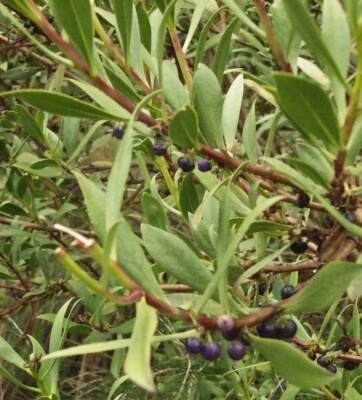
Source: projectnoah.org
How to Propagate Boobialla from Seed
Growing Boobialla from seed takes patience but is fairly reliable when done correctly. Boobialla need to be fully pollinated to produce viable seeds, so have a less than 50% chance of germination.
To help ensure germination, sow four to five seeds per pot, and sow them fresh from the tree in late summer or early autumn.
Tools needed:
- Warm water
- 9cm plastic pots
- Gravel
- Sandy soil
- Fresh Boobialla seeds
Sowing instructions:
- Mix an equal mix of gravel and sandy soil (or gravel, loamy soil and sand).
- Fill 9cm pots with the soil mixture, leaving a 5mm gap at the top of the pot.
- Remove any flesh from the berries, then soak Boobialla seeds overnight in warm water to soften their shells.
- Sow 4-5 seeds per pot, and cover with 2-3mm of soil and gravel.
- Water the pots by standing them in a tray of water until the surface is damp.
- Remove from the water and leave in a warm spot, with shelter from the afternoon sun*.
- Keep the soil reasonably moist, and protect it from extreme temperatures.
- Germination can take up to 12 months.
*While Boobialla grows best in full sun and well-drained soil, their seeds germinate naturally under the canopies of the parents, providing them with shade, and shelter. Avoid placing seeds in the full summer sun.
Boobialla Propagation from Cuttings
Boobialla is really easy to grow from cuttings, but they take time. The best time to take Boobialla cuttings is in late spring, using fresh green growth.
It’s essential to use non-flowering stems as flowering stems will continue to try to flower, even if the buds are removed, taking energy away from potential new roots.
Tools needed:
- Sharp, clean, bypass secateurs - see our review of the best secateurs available online.
- Gravel
- Sandy soil
- 9cm pots
- Rooting hormone
Method:
- In late spring or early summer, find young green shoots without any signs of flowers or buds.
- Cut back to a leaf node, taking 10-15cm of stem.
- Remove all but the top-most leaves from the cutting.
- Before planting, make a fresh cut just below a leaf node (this is where roots will appear).
- Dip the cutting in the rooting hormone.
- Fill a 9cm pot with an equal mix of gravel and garden soil.
- Use a pen or pencil to dig a hole in the soil, then gently drop the cutting into the hole.
- Water well, allowing the water to push soil around the stem (rather than pushing the soil by hand).
- Place in a cold frame, or on a warm windowsill away from direct sunlight, and keep the soil moist but not damp for the next 6-8 months.
- When roots start to grow from the base of the pot, your cutting is ready to plant out or move to a larger container.
How to Care for Boobialla
Established Boobialla don’t really need any care or attention in the garden unless you plan on harvesting their fruits and want to boost the harvest. To get the most out of a fruiting Boobialla, follow our guide.
Mulching Boobialla
Boobialla benefit from a bark mulch over winter in cooler climates with a risk of frost as they are not hardy below -5°C. Do scrape any mulches away in spring to prevent excess humidity during the growing season.
Click here to learn the different types of mulch, when, and how to use them.
What Fertiliser to Use
Like all native shrubs, Boobialla doesn’t need any fertiliser to thrive in garden soils in Australia but can benefit from a slow-release granular feed in spring if there are signs of weak growth.
Any balanced granular garden fertiliser is a useful addition to the soil around Boobialla, but not necessary if your plant is otherwise healthy.
Pruning Boobialla
Creeping and Prostrate Boobialla benefit from pruning in spring and should be cut back regularly to control their size. Like Juniper, Boobialla can recover from old wood, but only if it has to.
Try to avoid cutting into old wood if possible, and take just a few inches each time to allow the plant to bush out and retain a good form.
Boobialla Winter Care
Boobialla won’t survive temperatures below -5°C, so should be covered with a fleece in colder parts of Australia to avoid frost damage. Even in warmer climates, you should avoid pruning Boobialla in winter as this can promote frost damage, and fungal infection entering cut stems.
Boobialla Bush Tucker Guide
Boobialla makes outstandingly lovely jams, with a bitterness that helps to cut through its high sugar content, and creates a sophisticated flavour, unlike any other berry.

Source: apps.lucidcentral.org
When to Harvest Boobialla
In late summer or autumn, Boobialla should be covered in swathes of dark purple berries ready to pick. Pick by hand with a gentle tug, and place into a bucket as you harvest.
Take all the berries at once when they are ripe as birds will likely get to any that you leave on the plant and reduce your harvest dramatically.
How to Store Boobialla
After picking Boobialla there are a few different ways to prepare them for storage. By far the most popular is to create your own jams and preserves, but their flavour profile is similar to juniper making them perfect for wine and gin making too.
Once picked, Boobialla berries will keep in the fridge for around 2 weeks, or in the freezer for up to 6 months. Freezing helps to soften their texture and break down the sugars for a sweeter flavour but loses some of their defining bitterness, so try to use them fresh where possible.
Boobialla Pests and Diseases
Boobialla has no common pests in Australia, but if you notice clusters of curled leaves, it is probably an infestation of thrips. Simply treat the area with neem oil.
Thrips like damp soil and their eggs and larvae struggle to last through winter on well-drained earth, so maintain good drainage to avoid recurrences.
Pythium root rot
Pythium root rot is the only commonly occurring disease in these tough native plants, making them ideal for home gardeners looking for low-maintenance plants.
Boobialla needs well-drained soil in order to grow and thrive. Ignoring that advice will almost definitely lead to root rot. If you see yellowing leaves with brown tips, try to investigate the roots.
Brown, black or mushy roots are a clear sign of root rot, and there is often a stagnant smell when you dig into the soil around the base of plants with root rot.
There is no cure for root rot, but you can lift the plant, shake off its soil, and remove any damaged roots. This will harm the top growth, but by planting into new soil and treating with a liquid fungicide you can sometimes save shrubby plants like Boobialla.
Boobialla Frequently Asked Questions
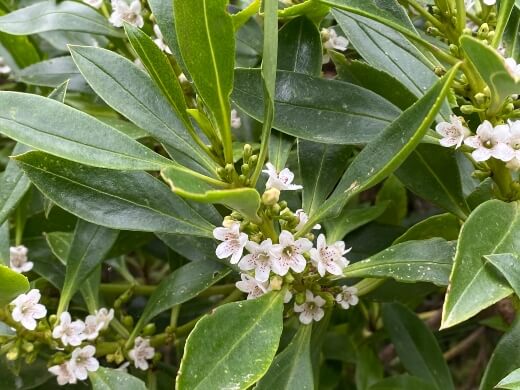
Source: inaturalist.ala.org.au
Are all Boobialla edible?
All species of Boobialla are edible, but be careful not to mix them with other Myoporum species. Many Myoporum have poisonous berries, and similar foliage, so familiarise yourself if you intend to forage.
Are Boobialla flowers edible?
Boobialla has edible berries, but the flowers, leaves and stems are toxic. Avoid eating any part of the plant other than ripe berries.
Is Boobialla fast growing?
Creeping Boobialla is very fast growing. Once roots establish, Boobialla can grow several feet per year, so should be pruned regularly from early spring through the late summer to maintain its shape and size.
Enjoy Boobialla Berries in Your Garden
Boobialla are beautiful shrubs that are hardy through most of Australia and provide year-round interest with gorgeous, honey-scented flowers, dense green foliage and delicate clusters of dark purple berries.
Some varieties even send out new purple shoots and leaves in spring, adding interest while the rest of the garden is starting to come into bloom.
While it might be illegal to harvest wild Boobialla berries, growing your own at home is easy, just follow our guide for how to grow Boobialla and you’ll be harvesting these tart but sweet berries in no time.
Published on August 1, 2022 by Nathan Schwartz
Last Updated on February 22, 2024

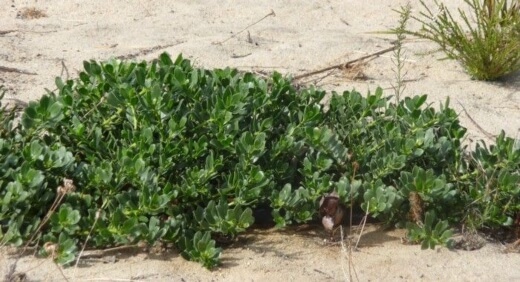




Great info thanks
The best!!